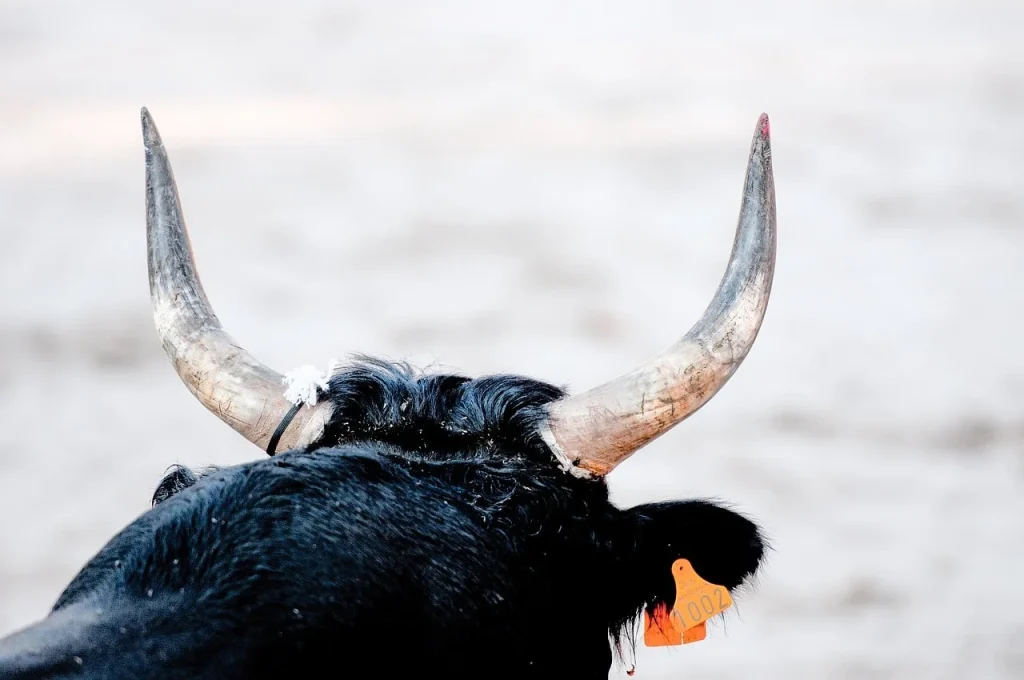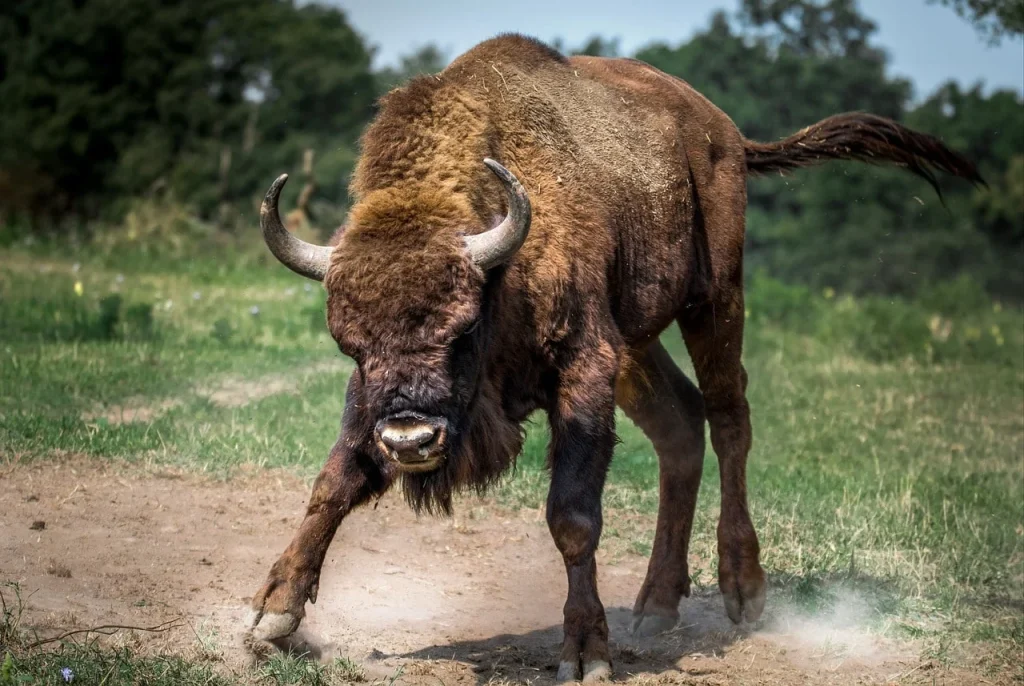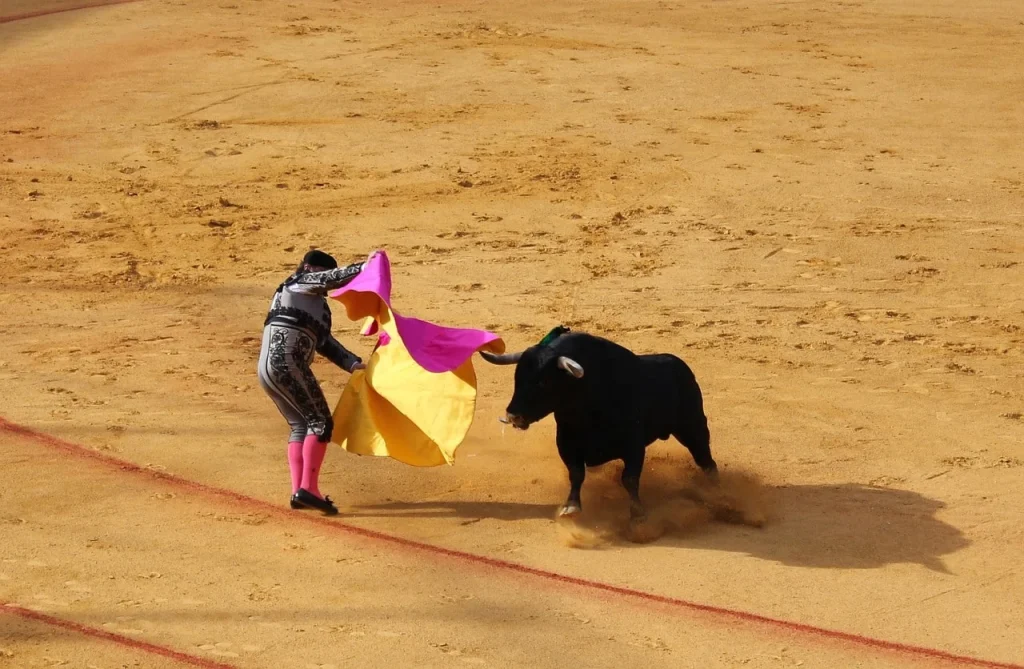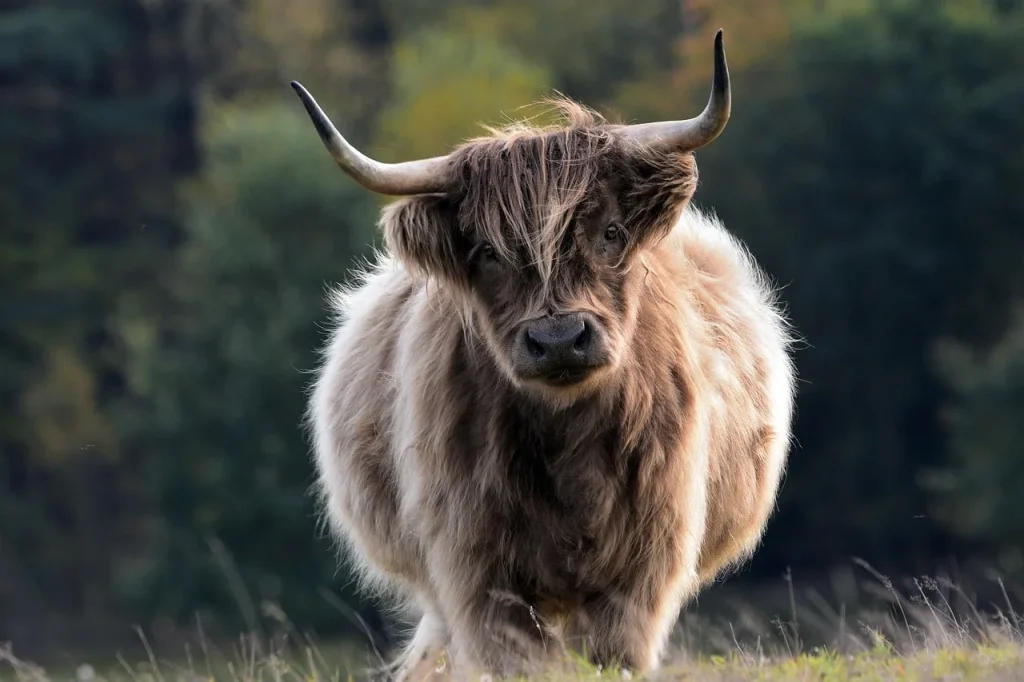What image comes to mind when you think of a bull? Perhaps you picture a powerful animal charging at a red flag. But there is so much more to these creatures than meets the eye.
Today, we’re diving into the world of bulls with some fun facts that go beyond their fierce reputation. From their role in ecosystems to their surprising emotional intelligence, let’s explore the lesser-known sides of bulls.
Bulls do not win bull fights. People do.
Norman Ralph Augustine
Bull Facts
Let’s start our journey in the fascinating world of bulls and arm yourself with knowledge! At the end of this article, test your expertise with a quiz designed to challenge even seasoned enthusiasts.
- Their horns can grow up to three feet in length.
- Papillae on their tongue help them grip tough, coarse grass while grazing.
- They have an excellent sense of smell and are capable of detecting scents up to six miles away.
- Known for their impressive memory, they can recognize and remember individuals for years.
- A group’s hierarchy is often established through head-butting contests.
- Contrary to popular belief, they are not naturally aggressive towards humans.
- They possess dichromatic vision, seeing colors in blues and yellows.
- The lifespan in the wild typically ranges from 15 to 20 years.
- Spain considers them a national symbol, prominently featured in cultural festivals.
- They can run at speeds of up to 35 miles per hour.
- During the Roman Empire, they were commonly used in arena games.
- The term “bull market” in finance symbolizes rising prices, inspired by the animal’s manner of charging.
- Selective breeding can lead to unique horn shapes for aesthetic or cultural purposes.

- Their heart weighs over 5 kilograms, which is vital for their large size and active lifestyle.
- Their digestive process involves rumination, which is part of why they chew so methodically.
- Females are capable of breeding until about the age of 20.
- Their social structure is matriarchal; female groups lead the herds.
- Historically, they have been a symbol of strength and fertility in many cultures.
- Despite their heavy physique, they are excellent swimmers.
- Ancient cave paintings, such as those in Lascaux, France, feature their ancestors.
- They have a gestation period of nearly 285 days.
- Color vision research shows they are more agitated by motion than by the color red.
- These animals are integral to biodynamic farming, helping to maintain crop diversity and soil health.
- Their manure is highly valued as a natural fertilizer rich in nutrients.
- Sharks and they share a surprising anatomical feature: a similar skin texture.
- Their hooves are split into two toes, each with a separate claw.
- Heat stress can significantly affect their milk production and overall health.
- In some cultures, their hides are used to make ceremonial drums and other musical instruments.

- Urban legends often depict them as monsters in various myths.
- Their nostrils can flare to significantly increase air intake during intense activity.
- They can lose up to 5 gallons of saliva per day through drooling, especially when anticipating food.
- Bulls are used by ranchers in North America for rodeo sports, including bull riding and roping.
- The bellow of a bull can be heard over long distances, serving as a communication tool within herds.
- In terms of biodiversity, certain breeds are now considered endangered due to industrial farming practices.
- Their tails serve as a mechanism to swat flies, featuring a tuft of hair on the end that acts as a whip.
- Protected areas have been established in various parts of the world to conserve rare breeds and prevent extinction.
- They play a pivotal role in the ecosystems of grasslands by helping to manage vegetation growth.
- Mechanical behaviors, such as using trees or rocks to scratch, are common for them to relieve skin irritation.

- Historically, they were traded as a form of currency and wealth in many ancient societies.
- During medieval times, they were often involved in plowing and other forms of heavy labor.
- The Bull-Leaping fresco from Minoan Crete suggests that they were involved in ancient sporting activities.
- Their footprints can help contribute to soil aeration, improving water absorption.
- Their eyelashes are unusually long, helping to protect their eyes from dust and debris.
- They can drink up to 35 gallons of water per day during hot weather.
- Their immune system is particularly robust, making them resistant to many diseases that affect other livestock.
- Their weightlifting capabilities are demonstrated by their ability to carry heavy loads, often exceeding half their body weight.
- Protective of their young, they exhibit paternal behaviors that are uncommon among cattle.
- The shape of their skull is designed to absorb impact, protecting the brain during confrontations.
- Their bones are dense and heavy, contributing significantly to their overall body weight.
- Historically, they have been depicted in star constellations, such as Taurus, symbolizing their significance in human culture.
Bull Myths

Now that we’ve covered the facts about bulls, let’s continue with some myths. It’s time to distinguish what’s true from what’s simply a tale.
- Bulls Hate the Color Red
It is often believed that bulls react aggressively to the color red. However, bulls are actually colorblind to red. The movement of the cape in bullfighting, not its color, is what provokes a reaction from the bull. - Bulls Are Inherently Aggressive
They may appear aggressive due to their size and strength, but they are not naturally inclined to attack. Aggression in bulls is usually provoked by fear, discomfort, or the need to protect their territory. - Bulls Can’t Climb Stairs
Contrary to popular belief, bulls are capable of climbing stairs. Descending stairs can be more challenging for them, largely due to their weight distribution and hoof structure. - A Ring Through the Nose of a Bull Is for Decoration
The ring seen in the noses of bulls serves a practical purpose rather than a decorative one. It is used to help handlers control the bull more easily, as sensitivity in this area can guide their movements. - Bulls Are Good for Bullfighting Only
They are often associated primarily with bullfighting, but they have a variety of uses. They are important in agriculture for breeding and can also be trained for work or as show animals in competitions.
No products found.
Bull Quotes

Below, I am writing some of my favorite quotes about bulls. You can share more in the comment section, and I will add them to the list.
If you’re in a bad situation, don’t worry it’ll change. If you’re in a good situation, don’t worry it’ll change.
John A. Simone, Sr.
This quote from John A. Simone, Sr., reflects on the unpredictable nature of life using a metaphor that could be related to the unpredictability of a bull’s behavior.
A bull market is like sex. It feels best just before it ends.
Barton Biggs
Barton Biggs, a well-known global investment strategist, humorously compares the exhilaration of a booming stock market to peak moments in human experience, noting both are fleeting.
You know you are on the road to success if you would do your job and not be paid for it.
Oprah Winfrey
Oprah Winfrey, a media mogul and philanthropist, uses this quote to express passion for one’s work, much like a bull charges with natural vigor regardless of the outcome.
The best way to fight a bull is not to be in the ring.
Unknown
This anonymous quote offers a pragmatic approach to problem-solving by suggesting avoidance of direct confrontation when unnecessary, much like avoiding a bullfight.
Don’t wave a red flag at the bull; improve your matador skills.
Bertolt Brecht
Bertolt Brecht, a German theatre practitioner and playwright, metaphorically suggests that rather than provoking challenges (like waving a red flag at a bull), one should focus on honing one’s skills to deal effectively with them.
Bull FAQ

Moving forward from the quotes, we arrive at our FAQ section. Read carefully because the quiz is just ahead. Ensure you understand these information well!
- Are bulls male cows?
Yes, they are indeed male cows. In cattle terminology, “bull” refers to an adult male of the species, while “cow” specifically refers to an adult female. - Can bulls swim?
Bulls, like most cattle, are capable swimmers. They may not swim often, but they can manage well in water when necessary. - Are bulls color blind?
They, along with other cattle, are not completely color blind, but they do have limited color vision. They can distinguish some colors, primarily in the blue and yellow range, but they have difficulty perceiving the red and green spectrum. - What bulls are used for bull riding?
Bulls used in bull riding are typically from breeds known for their agility and strength. The most common breed used in professional bull riding is the American Brahman, which is known for its large size and aggressive temperament. - Can bulls be friendly?
They can be friendly and docile if raised in a calm and nurturing environment. However, their large size and natural instincts can make them unpredictable, so they should always be treated with respect and caution.
No products found.
Bull Trivia

Welcome to the ultimate bull quiz! Get ready to grab the bull by the horns, because if you don’t score any points, we’ll have to assume you’re just here for the cow-tipping.
Bull Merch
If you are a true fan of bulls, then you definitely need to check out our merchandise. You can find T-shirts, hoodies, mugs, and tote bags for your favorite designs. Feel free to check out all the other designs in our shop.
Conclusion
By now, you should have a newfound appreciation for bulls. These creatures are not just powerful and strong but also have a rich history intertwined with human culture.
Their influence extends beyond the fields and into arenas, symbolizing strength and resilience. Let’s continue to learn and share stories about these remarkable animals, fostering a greater understanding and respect for them. Till next time, stay curious and explore more. Cheers.


